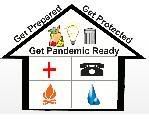# 3203
. . . and most people immediately think of the kind of pandemic in Stephen King’s The Stand, or Dustin Hoffman’s Outbreak, or perhaps Michael Crichton’s Andromeda Strain.
All three were enjoyable, edge-of-your-seat, highly fictionalized depictions of infectious disease outbreaks.
And luckily, none of them should be used as a guide to what an influenza pandemic would be like.
Even the great-granddaddy of all influenza pandemics (that we know of) – the 1918 Spanish Flu – only managed to sicken about 30% of the world’s population and kill less than 1 in 20 of them.
A terrible pandemic, yes.
But 98 out of 100 people survived it.
And the severity of illness and number of deaths varied considerably from place-to-place around the world.
Devastating, but hardly the end-of-the-world scenario that many books and movies like to present.
Now, is 1918 the worst that nature can throw at us?
Probably not.
And that is why the H5N1 virus, as difficult as it is to transmit between humans, has been so worrisome. The fatality rate (among known cases) currently runs about 60%.
Or 10 times greater than the Spanish flu.
But the virus before us now is neither the 1918 Spanish Flu, nor is it H5N1. It is a novel A/H1N1 `swine’ flu, that so far has mostly produced relatively mild symptoms in humans.
The key word here being,`mostly’.
For some people, the H1N1 virus has produced significant illness. And some people have died. Influenza is never a trivial illness. It kills hundreds of thousands of people every year.
Early studies have suggested that this new virus is about 4 times more severe than seasonal flu. Which puts it roughly as virulent as the 1957 Asian flu.
It’s a rough approximation, and one that I would be cautious about accepting completely. But right now, its the best data we have.
While you’ll no doubt grow tired of hearing it, influenza viruses are unpredictable. They mutate constantly.
We can’t know today what next month, or three months, or six months from now will bring. The virus, as it spreads between more and more hosts, has more opportunities to mutate.
These mutations could make this virus decrease in virulence, or increase in virulence. And these changes – if they do occur – may either be localized events, or could spread more widely.
We are facing a world full of variables, and anyone who thinks they know how all of this will turn out is just guessing.
Governments are concerned enough, however, to be authorizing huge expenditures for vaccines, antivirals, and other interventions fearing a pandemic in the Fall.
But as to the type of pandemic we may see?
It’s the $64 question.
It could be on a par with the very mild 1968 Hong Kong Flu, or it might be worse, more like what we saw in the 1957 Asian Flu. We might even get lucky, and see this new virus diminish or fizzle out
The concern is that this virus, which right now seems to prefer young victims, could gain virulence. That it could become an even stronger influenza than we saw in 1957.
We simply don’t know.
That isn’t fear mongering. That is simply the truth.
Prudence dictates that we all take simple steps now to prepare for what could be a difficult influenza season in the fall.
First, Public Health officials want people to remain mindful of the importance of`flu etiquette’'; washing hands frequently, using alcohol hand sanitizer, covering coughs, and staying home if ill.
If you own a business, you need to be planning on how to deal with employee absenteeism, social distancing, and other flu-related issues.
If you are an individual, you need to be planning on how you will cope if schools are closed and your children are home, or if you are ill and unable to take care of yourself or your children.
Those readers in the Southern Hemisphere have far less time to prepare, but even there, flu season doesn’t really ramp up for another month.
But while it is important to prepare, it is also important to keep a pandemic in perspective. They come in all sizes, and vary in impact from one region to the next.
If the WHO declares a pandemic level 6, it doesn’t signify the end of the world.
Of course, even a mild pandemic could make life very difficult - but if you are properly prepared - you can make it less so.
Good advice on personal and business planning for a pandemic, even a mild one, can be found at www.pandemicflu.gov.
For more information on how to prepare for emergencies, up to and including a pandemic, the following sites should be of assistance.
FEMA http://www.fema.gov/index.shtm
READY.GOV http://www.ready.gov/
AMERICAN RED CROSS http://www.redcross.org/
For Pandemic Preparedness Information:
For more in-depth emergency preparedness information I can think of no better resource than GetPandemicReady.Org.
Related Post:
Widget by [ Iptek-4u ]
